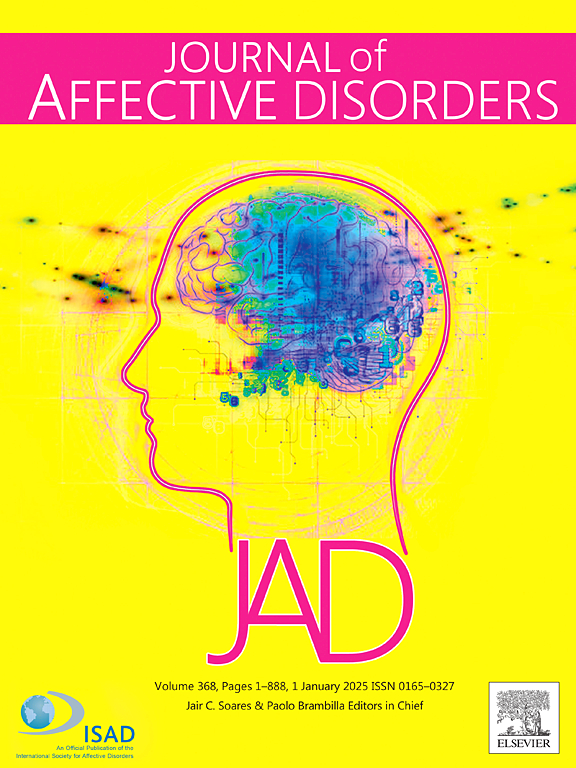Associations of exposure to heatwaves with depression and anxiety among adolescents: A cross-sectional study of the Chinese adolescent health survey
IF 4.9
2区 医学
Q1 CLINICAL NEUROLOGY
引用次数: 0
Abstract
Background
Limited research has examined the relationship between heatwaves and adolescent mental health, particularly depression and anxiety. This study aimed to explore the relationship between heatwaves and depression and anxiety.
Methods
We conducted a cross-sectional study including 19,852 adolescents (mean age 15.16 years; 50.2 % females). Air temperature data were from the fifth generation European ReAnalysis-Land (ERA5-Land) dataset. Heat exposure was assessed using three heatwave metrics: The excess heat factor-based (HWM1), maximum temperature-based (HWM2), and minimum temperature-based (HWM3) heatwave magnitude indices. Depression and anxiety were assessed using the PHQ-9 and GAD-7 scales. Subgroup analyses evaluated interactions with sex, grade and region of school.
Results
Depression and anxiety prevalence were 19.37 % and 16.27 %, respectively. Heatwaves were associated with depression (OR [95 % CI]: 1.13 [1.09–1.17]) and anxiety (OR [95 % CI]: 1.12 [1.08–1.16]) based on HWM1. Significant associations existed for depression alone (OR [95 % CI]: 1.14 [1.09–1.20]), anxiety alone (OR [95 % CI]: 1.13 [1.06–1.21]), and comorbid depression and anxiety (OR [95 % CI]: 1.13 [1.09–1.18]). Associations using HWM2 and HWM3 showed consistent directions but varied significance. We observed significant interactions between heatwaves and sex for anxiety alone, and between heatwaves and region of school for both depression alone and comorbid depression-anxiety (all P for interaction <0.05).
Limitations
The cross-sectional design constrained our capacity to draw causal inferences.
Conclusions
Heatwaves were associated with a significant of prevalence depression, anxiety, and their comorbidity, with males and rural students potentially more susceptible to these effects.
热浪暴露与青少年抑郁和焦虑的关系:中国青少年健康调查的横断面研究
有限的研究调查了热浪与青少年心理健康之间的关系,特别是抑郁和焦虑。本研究旨在探讨热浪与抑郁和焦虑之间的关系。方法对19552名青少年进行横断面研究,平均年龄15.16岁;50.2%为女性)。气温数据来自第五代欧洲reanalysisland (ERA5-Land)数据集。热暴露评估使用三个热浪指标:基于余热因子(HWM1),基于最高温度(HWM2)和基于最低温度(HWM3)热浪量级指数。抑郁和焦虑采用PHQ-9和GAD-7量表进行评估。分组分析评估了性别、年级和学校地区之间的相互作用。结果抑郁和焦虑患病率分别为19.37%和16.27%。基于HWM1,热浪与抑郁(OR [95% CI]: 1.13[1.09-1.17])和焦虑(OR [95% CI]: 1.12[1.08-1.16])相关。单独的抑郁(OR [95% CI]: 1.14[1.09-1.20])、单独的焦虑(OR [95% CI]: 1.13[1.06-1.21])和合并抑郁和焦虑(OR [95% CI]: 1.13[1.09-1.18])存在显著相关性。HWM2和HWM3的关联方向一致,但显著性不同。我们观察到热浪与性别之间存在显著的交互作用,而热浪与学校区域之间存在显著的交互作用(P均为交互作用<;0.05)。局限性横断面设计限制了我们得出因果推论的能力。结论:脑电波与抑郁、焦虑及其合并症的患病率显著相关,男性和农村学生可能更容易受到这些影响。
本文章由计算机程序翻译,如有差异,请以英文原文为准。
求助全文
约1分钟内获得全文
求助全文
来源期刊

Journal of affective disorders
医学-精神病学
CiteScore
10.90
自引率
6.10%
发文量
1319
审稿时长
9.3 weeks
期刊介绍:
The Journal of Affective Disorders publishes papers concerned with affective disorders in the widest sense: depression, mania, mood spectrum, emotions and personality, anxiety and stress. It is interdisciplinary and aims to bring together different approaches for a diverse readership. Top quality papers will be accepted dealing with any aspect of affective disorders, including neuroimaging, cognitive neurosciences, genetics, molecular biology, experimental and clinical neurosciences, pharmacology, neuroimmunoendocrinology, intervention and treatment trials.
 求助内容:
求助内容: 应助结果提醒方式:
应助结果提醒方式:


